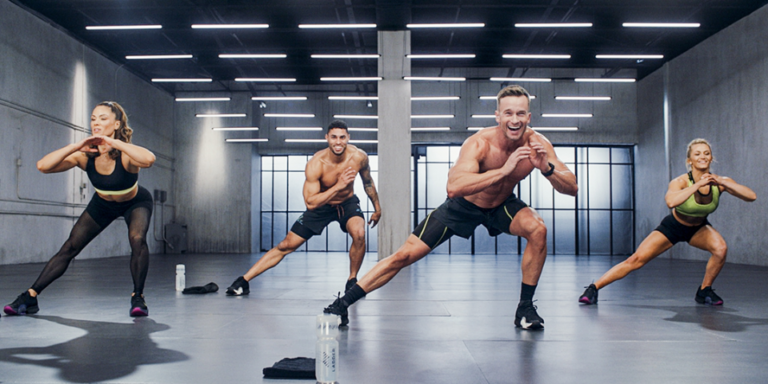
Think that bodyweight exercises are “easy” or “beginner” level because they don’t require heavy lifting? Think again! Using your body to train not only saves money and space, but it’s also highly effective. Gym equipment definitely has its place, but you can get a killer workout using only your own body.
Read on to learn why common bodyweight exercise myths simply aren’t true and how useful these exercises can be. Plus, we share the scoop on our program Just Bring Your Body, which uses nothing but bodyweight moves to totally transform your body from head to toe in 60 days.
Myth 1. It’s Not Effective for Weight Loss

Paired with a healthy diet and calorie deficit, bodyweight exercises can help keep your weight in check, cultivate calorie-burning muscles, and accelerate your fitness aims. “Bodyweight exercises can be a boon for your health and help you reach, if not exceed, your fitness goals,” says John Fawkes, an NSCA-certified personal trainer.
In fact, these two bodyweight training protocols are especially good at shedding extra pounds:
Circuit training: Performing a series of exercises back-to-back increases the intensity and the metabolic cost, leading to more calories (and fat) burned. Compound, multi-joint movements give you the greatest return on your effort, as they engage the most muscle (aka “metabolically active tissue”).
Bodyweight HIIT workouts: HIIT workouts involve brief bursts of high-intensity intervals followed by periods of low-intensity recovery. Bodyweight HIIT workouts (like plyo push-ups) keep your metabolism elevated for hours after your last rep so that you burn more total calories.
Myth 2. You Can’t Increase Strength
To keep building strength and muscles, and make your workouts more challenging, up your reps, reduce your rest time between reps, and hone your technique, Fawkes says.
If you feel like you’ve hit a plateau in your fitness plans, you can try “training to failure.” This means pushing yourself to the point of muscle fatigue, where you feel like you just can’t do that last rep. Data published in the Journal of Strength and Conditioning Research states that “training to failure” can help those that are already fit and strong overcome training plateaus.
The key here, however, is to only “train to failure” on occasion. Otherwise, you may set yourself up for poor technique, overstrain, and injury, Fawkes cautions.
Myth 3. You Can’t Do Bodyweight Exercises Every Day

Bodyweight exercises can absolutely be done every day in a safe and effective way to help you see results. Plus, the nature of bodyweight training lends itself to daily practice; you don’t need to go anywhere or buy anything.
“That said, if you’re doing bodyweight exercises daily, be sure to use a variety of exercises that target different areas and reduce the volume of reps so that you don’t overstrain yourself,” Fawkes says.
Just Bring Your Body was expertly designed with consecutive workouts five days a week to make sure you’re not overworking certain muscle groups. You’ll get the perfect mix of cardio, strength training, and core work to build muscle as you burn calories, improve mobility, and carve your abs.
Myth 4. Not Feeling Sore Means It’s Not Working
No matter what type of workout you do, being sore isn’t a sign of an exercise “working,” nor is it a sign of a “good” workout.
There is very little evidence that muscle soreness is the lead indicator of muscle growth. Studies show that the idea of “no pain, no gain” is a false way of thinking because soreness happens when microtrauma (muscle overuse) happens — the inflammation process starts, which can occur whether or not you lift weights.
Myth 5. You Can’t Adjust Resistance With Bodyweight Exercise

There are plenty of ways to make bodyweight exercises harder or easier. One way is to change the angle and leverage, says personal trainer Pete McCall, ACE, NASM, author of Smarter Exercise: The Science of Exercise Made Simple. You can do push-ups with your hands elevated on a step or bench to make them easier or with your feet elevated on a box to increase the challenge.
Playing around with tempo, slowly lowering, and then exploding up may also add resistance and challenge to any workout. The JBYB trainers will help you learn how to adjust your resistance to shake up your workouts.
Myth 6. You Don’t Need Rest Days
What qualifies as a “rest” day depends solely on you. Treat bodyweight training like any other type of training, which is to say that you need sufficient recovery time between workouts to perform at your peak and optimize your results. Try alternating your harder workouts with active rest days.
“You can do bodyweight exercise every day,” McCall says. “But switch up the modalities, so you are moving differently, at different speeds and different ranges of motion.”